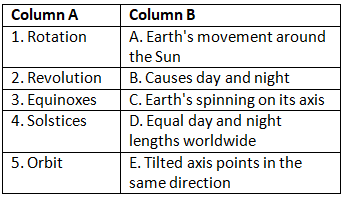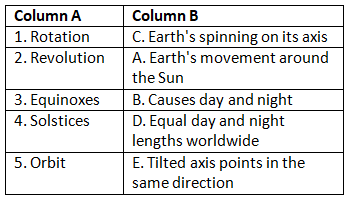Worksheet Solutions: Movements of the Earth | Be an Explorer 5: Book Solutions, Notes & Worksheets - Class 5 PDF Download
Q1: Multiple Choice Questions (MCQs).
(i) What is the Earth's movement on its own axis called?
(a) Revolution
(b) Rotation
(c) Orbit
(d) Tilt
Ans: (b)
Rotation refers to the Earth's spinning motion on its axis, causing day and night.
(ii) How long does it take for the Earth to complete one rotation?
(a) 12 hours
(b) 24 hours
(c) 36 hours
(d) 48 hours
Ans: (b)
It takes approximately 24 hours for the Earth to complete one full rotation, leading to a day and night cycle.
(iii) In which direction does the Earth rotate?
(a) East to West
(b) West to East
(c) North to South
(d) South to North
Ans: (b)
The Earth rotates from west to east, causing the Sun to appear to rise in the east and set in the west.
(iv) What causes day and night on Earth?
(a) Revolution
(b) Tilt of the axis
(c) Rotation
(d) Orbit
Ans: (c)
Day and night are a result of the Earth's rotation, where one half faces the Sun (day) while the other is in darkness (night).
(v) Who strengthened Copernicus' belief in the Earth's movement and proved the Sun is at the center of the Solar System?
(a) Galileo Galilei
(b) Nicolaus Copernicus
(c) Johannes Kepler
(d) Isaac Newton
Ans: (a)
Galileo Galilei supported Copernicus' heliocentric model through observations and experiments.
Q2: Fill in the Blanks.
(i) Rotation causes the occurrence of __________ and __________.
Ans: Day and Night
Rotation of the Earth results in the alternating periods of day and night.
(ii) The Earth takes ________ hours to complete one rotation.
Ans: 24 hours
A full rotation of the Earth takes 24 hours, defining a day.
(iii) Revolution is the Earth's movement around the ________.
Ans: Sun
Revolution involves the Earth orbiting around the Sun.
(iv) Solstice days mark the times when the Northern Hemisphere is tilted towards or away from the ____.
Ans: Sun
Solstices are related to the tilt of the Earth's axis concerning the Sun.
(v) Equinoxes occur when the Sun's rays fall directly on the ________.
Ans: Equator
Equinoxes result in equal day and night lengths worldwide when the Sun is directly over the Equator.
Q3: Match the Column.
 Ans:
Ans:
Q4: True or False.
(i) The Earth's rotation causes the Sun to rise in the west and set in the east.
Ans: False
The Earth's rotation causes the Sun to rise in the east and set in the west.
(ii) Solstices occur when the Northern Hemisphere has the longest day and shortest night.
Ans: True
During the Summer Solstice, the Northern Hemisphere experiences the longest day.
(iii) Equinoxes result in unequal day and night lengths globally.
Ans: False
Equinoxes bring equal day and night lengths worldwide.
(iv) Rotation is the Earth's movement around the Sun.
Ans: False
Rotation is the Earth's spinning on its axis, while revolution is its movement around the Sun.
(v) The Earth experiences four major seasons due to its tilted axis.
Ans: True
The Earth's tilted axis causes different parts to receive varying amounts of sunlight, leading to seasons.















